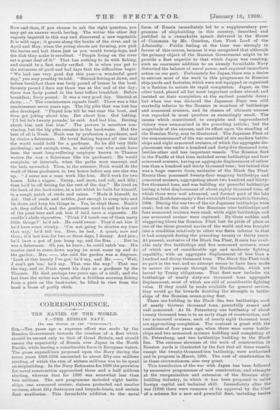CORRESPONDENCE.
THE NAVIES OF THE WORLD. V.—THE RUSSIAN NAVY. [TO TEEN EDITOR. or vrnc " SPECTATOR."] SIR,—Ten years ago a supreme effort was made by the Russian Government towards the creation of a fleet which should be second only to that of Great Britain, and should assure the superiority of Russia over Japan in the North Pacific, while leaving a considerable force in European waters. The gross expenditure proposed upon the Navy during the seven years 1898-1904 amounted to about fifty-one millions sterling, of which the sum of sixteen millions was to be spent on shipbuilding. In the Navy Estimates for 1899 the provision for naval construction approached three and a half millions sterling, whereas that for 1898 was somewhat less than two millions. The new programme included eight battle- ships, one armoured cruiser, sixteen protected and smaller cruisers, about fifty destroyers and torpedo-boats, and certain fleet auxiliaries. This formidable addition to the naval force of Russia immediately led to a supplementary pro- gramme of shipbuilding in this country, described and justified in a remarkable speech delivered in the House of Commons by Mr. Gosehen, then First Lord of the Admiralty. Public feeling at the time was strongly in favour of this course, because it was recognised that although the primary object of the Russian Government might be to provide a fleet superior to that which Japan was creating, such an enormous addition to an already formidable Navy disturbed the balance of naval power, and required immediate action on our part. Fortunately for Japan, there was a desire to entrust most of the work in this programme to Russian ship-yards and factories, which were not equipped or organised in a fashion to secure its rapid completion. Japan, on the other hand, placed all her most important orders abroad, and insisted on their completion at the earliest possible dates ; but when war was declared the Japanese Fleet was still markedly inferior to the Russian in numbers of battleships and armoured cruisers, and its chance of ultimate success was regarded in most quarters as exceedingly small. The causes which contributed to complete and unprecedented victory were summarised in the preceding article; but the magnitude of the success, and its effect upon the standing of the Russian Navy, may be illustrated. The Japanese Fleet at the commencemenf of the war consisted of six modern battle- ships and eight armoured cruisers, of which the aggregate dis- placement was under a hundred and forty-five thousand tons, besides other and less important vessels. The Russian fleet in the Pacific at that time included seven battleships and four artnoured cruisers, having an aggregate displacement of rather less than a hundred and thirty thousand tons ; but behind this was a huge reserve force, exclusive of the Black Sea Fleet. Russia then possessed twenty-four seagoing battleships and armoured cruisers, aggregating about two hundred and thirty- five thousand tons, and was building six powerful battleships having a total displacement of about eighty thousand tons, of which three were well advanced, and formed part of the late Admiral Rozhelestvensky's fleet which left Cronstadt in October, 1904. During the war two of the six Japanese battleships were sunk; but on the side of the Russians nine battleships and four armoured cruisers were sunk, while eight battleships and one armoured cruiser were captured. By these sudden and staggering blows the Russian Fleet lost its pride of place as one of the three greatest navies of the world, and was brought into a condition relatively to other war fleets inferior to that it had occupied during the preceding twenty or thirty years. At present, exclusive of the Black Sea Fleet, Russia has avail- able only five battleships and five armoured cruisers, seine of which are of considerable age and moderate fighting capability, with an aggregate displacement of less than a hundred and thirty thousand tons. The Black Sea Fleet took no part in the war, and no attempt seems to have been made to secure its passage through the Dardanelles, which are barred by Treaty obligations. That fleet now includes six battleships of nearly sixty-six thousand tons aggregate displacement, most of which are still of considerable fighting value. If they could be made available for general service, they would go far towards doubling the strength in battle- ships of the Russian ocean-going fleet.
There are building in the Black Sea two battleships, each of nearly thirteen thousand tons, powerfully armed and well armoured. At St. Petersburg one battleship of about twenty thousand tons is in an early stage of construction, and two armoured cruisers, each of nearly eight thousand tons, are approaching completion. The contrast is great with the conditions of four years ago, when there were seven battle- ships and two armoured cruisers building and completing at St. Petersburg, and two battleships building in the Black Sea. The extreme slowness of the work of construction in Russian yards is illustrated by the fact that all these vessels, except the twenty-thousand-ton battleship, were authorised and in progress in March, 1905. The cost of construction is, in these circumstances, also very great.
This humiliation of the war with Japan has been followed by successive programmes of new construction, and attempts at the reorganisation and extension of the Russian ship- building industry, in which it has been proposed to enlist foreign capital and technical skill. Immediately after the war (1906) there were rumours of the approval by the Czar of a scheme for a new and powerful fleet, including twelve
battleships, fifteen cruisers, forty-six destroyers, eighteen named Pollock are said to have cleared eleven thousand torpedo-boats, and ten submarines, the outlay upon which families off a tract about forty miles long in Roscommon and would have been e»ormous and the time occupied consider- Galway. That is whore cattle-driving began a couple of years able, as it was proposed to do all the work in Russia and ago. There were notable clearances, too, in Tipperary, and with Russian materials. During the last two years other one of the chief evictors was a Mr. Cowden, whose namesake Proposals have been made, but practically nothing has (and representative, I presume) is now edifying the British yet come of them; and the financial position doubtless public with pictures of lawlessness in that county.
explains this delay. It may be anticipated, however, But all Irish landlords did not pursue this policy. What notwithstanding speeches and . writings advocating an happened to the others who left their tenants on the soil P In abandonment of the traditional naval policy due to Peter 1881 the State stepped in, declared that the rent should be the Great, that it will be maintained and brought into fixed by a Court, and that the tenant owned a saleable interest practical operation again as soon as the necessary funds in his bolding. This may have been confiscation, but it was Can be provided. No real success will be achieved, nor can justified in the public interest by the late Duke of Devon- economical results be obtained, until there is a complete shire, and I would not swear that the Spectator did not rearrangement of the central organisation of the Russian approve. Meanwhile the evictor, or the heir of the evictor, Admiralty, as well as of the ship-yatais and factories. The went scot-free. We claim now that the State shall deal with system of Committees has been so greatly developed that the "unoccupied land"—that is, in nine cases out of ten, land sense of personal responsibility has been seriously weakened, from which tenants were removed—in the spirit of the Irish and procedure has become dilatory. Russian naval con-





































 Previous page
Previous page